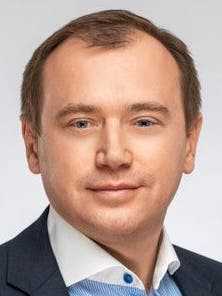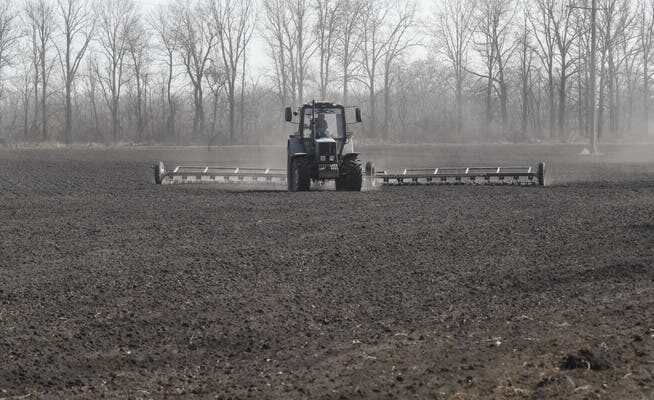Farmers currently have to take care of the spring sowing. From an economic point of view, this is a difficult decision. Because the war has made many things uncertain. Alex Lissitsa, head of the agricultural company IMC, explains what the industry and consumers in the West need to prepare for.
Agriculture in Ukraine had made great technical and economic advances before the war.
The large agricultural companies in Ukraine, but also many independent farmers, are faced with the existential question: should they sow the seeds like every spring despite the war, even though they risk not being able to harvest? Spring sowing season is beginning in Ukraine, which usually lasts until May 15th. “I discuss this almost constantly with my colleagues in chats,” says Alex Lissitsa (47), head of the Ukrainian agricultural company IMC, which grows corn, wheat and sunflowers.
“If we don’t sow the seeds, the money will last until the end of the year,” says the manager of the company, which is listed on the Warsaw Stock Exchange. But bankruptcy may follow in the coming year. Anyone who hesitates now will lack the income.
How long is there still wages?

Alex Lissitsa, head of agricultural company IMC.
Lissitsa has therefore decided to sow despite the war. At least where that is possible. IMC manages an agricultural area of 120,000 hectares, mainly north and south-east of the capital Kyiv. Some of the regions where the IMC fields are located were still occupied by the Russian army on Thursday.
However, Lissitsa has observed that associations have withdrawn, for example from the region around the city of Chernihiv. The head of the company, who earned his doctorate in agricultural economics in Berlin, estimates that IMC can use around half of the acreage in the current year.
Because the prospects are so uncertain, Lissitsa has already ordered austerity measures. “We stopped investment projects,” says the manager. For example, IMC is currently not buying new agricultural machinery.
The prospects for employees are also uncertain. You did receive the March wages, and Lissitsa also promised the approximately 2,000 employees the salary for April. “But what are we going to do in May? We don’t know, »says the company boss. Especially since around 400 employees are currently engaged in defense tasks and do not work for the company at all.
Broken export routes
But that’s not the only uncertainty plaguing Ukrainian agribusinesses and farmers at the moment. They will produce some, but it is very uncertain how the products can be exported. IMC, for example, generates 80 percent of its income from exports.
Exports via the Black Sea ports seem to be impossible because of the sea mines, especially since access routes such as railway bridges have been destroyed. Even if the war doesn’t last as long as some fear, export prospects remain uncertain. “How long will it take to make the way across the sea safe again?” asks Lissitsa.
The Ukrainian government is therefore looking for ways to transport at least some of the agricultural products to EU countries by rail. But there are also hurdles. Some of the Ukrainian trains are used by the army, so they are not available.
In addition, most of the rail network is broad gauge. Agricultural goods must therefore be reloaded from one train to another at the border. Lissitsa estimates that compared to the past, Ukraine will probably be able to export no more than ten percent of the grain volume.
Huge fields
The war is throwing back a sector that was a role model before the Russian invasion. Agriculture accounts for 10 percent of Ukraine’s gross domestic product. Before the war, however, hardly anyone in the West was aware of how important the Ukrainian agricultural sector is for supplying certain countries. However, the government of Ukraine has never succeeded in promoting the industry’s image in a sustained manner.
At the same time, agriculture in Ukraine has dimensions that are unimaginable in Switzerland. A Swiss farm covers an average of 25 hectares; in Ukraine, on the other hand, there are a few agricultural companies that cultivate areas of several hundred thousand hectares of land.
IMC is one of the ten largest providers. The giant of the industry is the company Kernel, also listed on the Warsaw Stock Exchange, with a “land bank” of 500,000 hectares and a turnover of 5.6 billion dollars (2021). In the case of IMC, the huge individual fields cover up to 1200 hectares.
Companies have made great progress in recent years, both economically and technologically. IMC boss Lissitsa is proud of the fact that the corn yield has increased from 7 tons per hectare to 10.6 tons since 2013. The company has invested money in digitization, employs a chief technology officer and runs a small research and development department.
IMC is therefore more likely to be a pioneer than the norm in the Ukraine. “The country’s agricultural companies still have a lot of room to improve their efficiency,” says economist Olga Pindyuk from the Vienna Institute for International Economic Comparisons (WIIW).
Ultimately, Ukraine has the same problem as all countries that export large quantities of agricultural products or metals. “Entrepreneurs should try harder to export more processed goods instead of heavy raw materials,” says Pindyuk. This would give them greater added value.
Although this development has taken place among Ukrainian agribusinesses, the war is now throwing them back. The IMC boss Lissitsa still exudes fighting spirit, especially when he comments on the political Lange. “We were petrified in the first week of the Russian attack,” he says. “We now know that Ukraine will continue to exist.”
